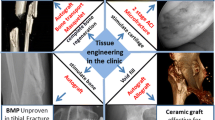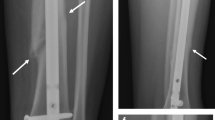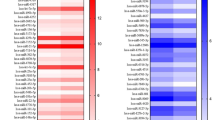Abstract
Injuries to growth plates may initiate the formation of reversible or irreversible bone-bridges, may leading to bone length discrepancy or axis deviation. As vascular invasion is essential for the formation of bone tissue, the aim of our study was to investigate the kinetic expression of Vascular Endothelial Growth Factor (VEGF) and its receptors R1 and R2 and the ingrowth of vessels in the formation of bone bridges in a rat physeal injury model. Quantitative Real-Time Polymerase Chain Reaction was performed for VEGF and its receptors. Samples from the proximal physis of the tibial bone were immunohistochemically evaluated for the expression of VEGF and its R1 and R2 receptors and Laminin. Morphologically, physeal bone bridge formation was validated by means of Magnetic Resonance Imaging. Kinetic expression of VEGF and VEGF-R1 mRNA documented a tendency towards an increase in expression on day 7. Histological analyses showed a hematoma containing bone debris on day 1 which was replaced with bony trabeculae by day 14, forming a bone bridge by day 28 which was preceded and accompanied by angiogenesis and consistent with MRI data. VEGF and VEGF-R2 was expressed on the debris within the hematoma and bone trabeculae from days 1 to 28. VEGF-R1 expression was only noted until day 14. The findings of our study suggest that physeal bone bridge formation is in part triggered by VEGF expression and associated with angiogenesis, which was shown to precede bone bridge formation and may be further stimulated through VEGF-positive bone debris.










Similar content being viewed by others
References
Arasapam G, Scherer M, Cool JC, Foster BK, Xian CJ (2006) Roles of COX-2 and iNOS in the bony repair of the injured growth plate cartilage. J Cell Biochem 99:450–461
Carano RAD, Filvaroff EH (2003) Angiogenesis and bone repair. Drug Discovery Today 8:980–989
Chung R, Cool JC, Scherer M, Foster BK, Xian CJ (2006) Roles of neutrophil-mediated inflammatory response in the bony repair of injured growth plate cartilage in young rats. J Leukoc Biol 80(6):1272–1280
Chung R, Foster BK, Zannettino AC, Xian CJ (2009) Potential roles of growth factor PDGF-BB in the bony repair of injured growth plate. Bone 44(5):878–885
Ferrara N, Gerber HP, LeCouter J (2003) The biology of VEGF and its receptors. Nat Med 9:669–676
Fiedler J, Leucht F, Waltenberger J, Dehio C, Brenner RE (2005) VEGF-A and PlGF-1 stimulate chemotactic migration of human mesenchymal progenitor cells. Biochem Biophys Res Commun 334:561–568
Fong GH, Rossant J, Gertsenstein M, Breitman ML (1995) Role of the Flt-1 receptor tyrosine kinase in regulating the assembly of vascular endothelium. Nature 376:66–70
Garces GL, Mugica-Garay I, Lopez-Gonzalez Coviella N, Guerado E (1994) Growth-plate modifications after drilling. J Pediatr Orthop 14:225–228
Gerber HP, Vu TH, Ryan AM, Kowalski J, Werb Z, Ferrara N (1999) VEGF couples hypertrophic cartilage remodeling, ossification and angiogenesis during endochondral bone formation. Nat Med 5:623–628
Kleinheinz J, Stratmann U, Joos U, Wiesmann HP (2005) VEGF-activated angiogenesis during bone regeneration. J Oral Maxillofac Surg 63:1310–1316
Koch S, Tugues S, Li X, Gualandi L, Claesson-Welsh L (2011) Signal transduction by vascular endothelial growth factor receptors. Biochem J 437(2):169–183
Komatsu DE, Hadjiargyrou M (2004) Activation of the transcription factor HIF-1 and its target genes, VEGF, HO-1, iNOS, during fracture repair. Bone 34:680–688
Lee MA, Nissen TP, Otsuka NY (2000) Utilization of a murine model to investigate the molecular process of transphyseal bone formation. J Pediatr Orthop 20:802–806
Mark H, Penington A, Nannmark U, Morrison W, Messina A (2004) Microvascular invasion during endochondral ossification in experimental fractures in rats. Bone 35:535–542
Martin EA, Ritman EL, Turner RT (2003) Time course of epiphyseal growth plate fusion in rat tibiae. Bone 32:261–267
Mayer H, Bertram H, Lindenmaier W, Korff T, Weber H, Weich H (2005) Vascular endothelial growth factor (VEGF-A) expression in human mesenchymal stem cells: autocrine and paracrine role on osteoblastic and endothelial differentiation. J Cell Biochem 95:827–839
Mayr-Wohlfart U, Waltenberger J, Hausser H, Kessler S, Günnther KP, Dehio C, Puhl W, Brenner RE (2002) Vascular endothelial growth factor stimulates chemotactic migration of primary human osteoblasts. Bone 30:472–477
Nakagawa M, Kaneda T, Arakawa T, Morita S, Sato T, Yomada T, Hanada K, Kumegawa M, Hakeda Y (2000) Vascular endothelial growth factor (VEGF) directly enhances osteoclastic bone resorption and survival of mature osteoclasts. FEBS Lett 473:161–164
Pufe T, Wildemann B, Petersen W, Mentlein R, Raschke M, Schmidmaier G (2002) Quantitative measurement of the splice variants 120 and 164 of the angiogenic peptide vascular endothelial growth factor in the time flow of fracture healing: a study in the rat. Cell Tissue Res 309:387–392
Seil R, Pape D, Kohn D (2008) The risk of growth changes during transphyseal drilling in sheep with open physes. Arthroscopy: The Journal of Arthroscopic & Related Surgery 24:824–833
Street J, Lenehan B (2009) Vascular endothelial growth factor regulates osteoblast survival - evidence for an autocrine feedback mechanism. J Orthop Surg Res 4:19
Street J, Bao M, deGuzman L, Bunting S, Peale FV, Ferrara N, Steinmetz H, Hoeffel J, Cleland JL, Daugherty A, van Bruggen N, Redmond HP, Carano RAD, Filvaroff EH (2002) Vascular endothelial growth factor stimulates bone repair by promoting angiogenesis and bone turnover. Proc Natl Acad Sci USA 99:9656–9661
Takahashi T, Ueno H, Shibuya M (1999) VEGF activates protein kinase cdependent, but Ras-independent Raf-MEK-MAP kinase pathway for DNA synthesis in primary endothelial cells. Oncogene 18:2221–2230
Timpl R, Rohde H, Robey PG, Rennard SI, Foidart JM, Martin GR (1979) Laminin–a glycoprotein from basement membranes. Journal of Biological Chemistry 254:9933–9937
Uchida S, Sakai A, Kudo H, Otomo H, Watanuki M, Tanaka M, Nagashima M, Nakamura T (2003) Vascular endothelial growth factor is expressed along with its receptors during the healing process of bone and bone marrow after drill-hole injury in rats. Bone 32:491–501
Weinberg AM, Tscherne H (2006) Tscherne Unfallchirurgie: Unfallchirurgie im Kindesalter (Allgemeiner Teil, Kopf, Obere Extremität, Wirbelsäule), vol 1, 1st edn. Springer, Berlin
Xian CJ, Zhou FH, McCarty RC, Foster BK (2004) Intramembranous ossification mechanism for bone bridge formation at the growth plate cartilage injury site. J Orthop Res 22:417–426
Acknowledgments
The project S-06-96 W was supported by the AO Research Fund of the AO Foundation. They played no further role in study design; in the collection, analysis, and interpretation of data; in the writing of the report; and in the decision to submit the paper for publication, after the approval of the grant. We would like to acknowledge Maximilian Seles, MD, and Martin Manninger, MD, for their great work in analyzing the immunohistochemical expression of VEGF and its receptors R1 and 2 at the physeal injury site which was object of their doctoral thesis. Furthermore, we would like to thank Ursula Neun, MD, and Elisabeth Wadl, MD, for their contribution to this paper by investigating the immunohistochemical expression of Collagen I and II, and Laminin, respectively, which was also focus of their doctoral thesis. Eventually, we would also like to acknowledge Martina Rupp, DI, for their scientific input and for editing this paper. The monoclonal antibody 2E8/anti-laminin, developed by Eva Engvall, Ph.D., and the antibody CllC1/collagen type II, contributed by Holmdahl F. and Rubin K., were obtained from the Developmental Studies Hybridoma Bank developed under the auspices of the NICHD and maintained by The University of Iowa, Department of Biology, Iowa City, IA 52242. There is no actual or potential conflict of interest including any financial, personal or other relationships with other people or organizations that could inappropriately influence or bias our work.
Author information
Authors and Affiliations
Corresponding author
Rights and permissions
About this article
Cite this article
Fischerauer, E., Heidari, N., Neumayer, B. et al. The spatial and temporal expression of VEGF and its receptors 1 and 2 in post-traumatic bone bridge formation of the growth plate. J Mol Hist 42, 513–522 (2011). https://doi.org/10.1007/s10735-011-9359-x
Received:
Accepted:
Published:
Issue Date:
DOI: https://doi.org/10.1007/s10735-011-9359-x




